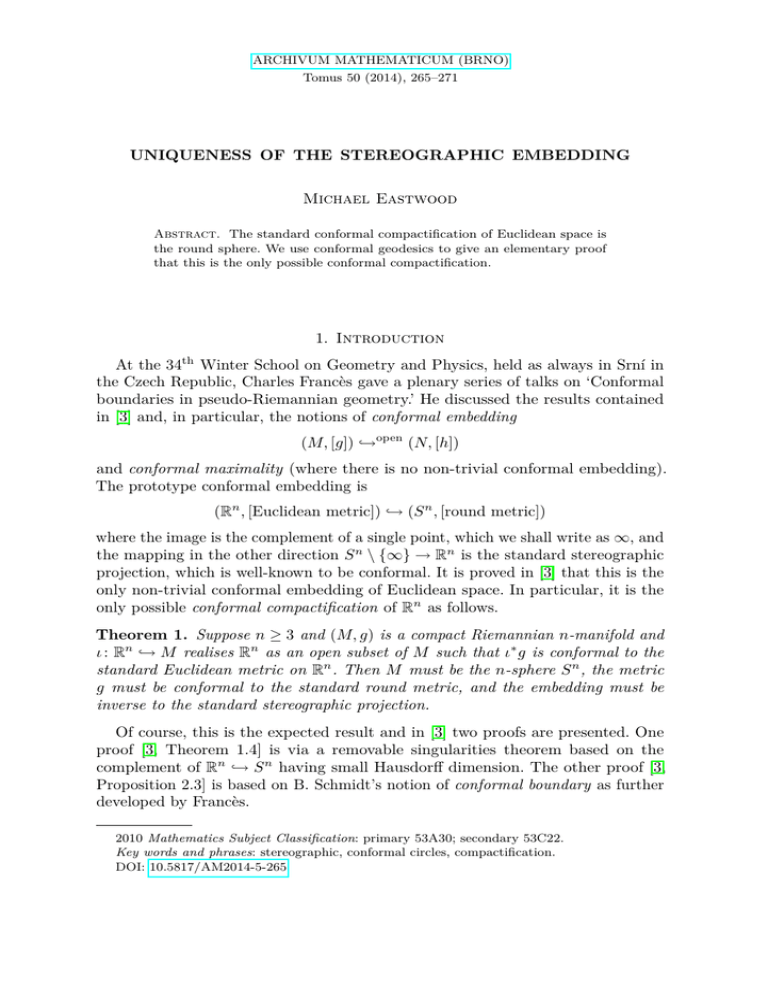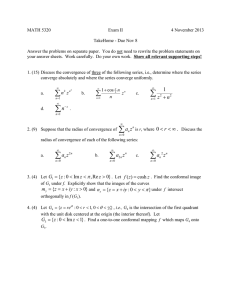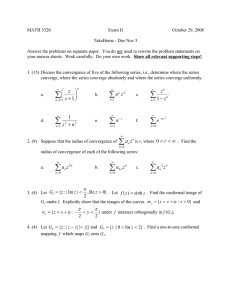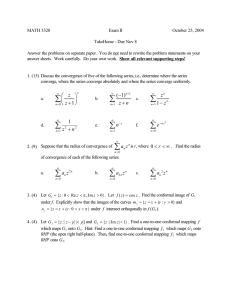UNIQUENESS OF THE STEREOGRAPHIC EMBEDDING Michael Eastwood
advertisement

ARCHIVUM MATHEMATICUM (BRNO)
Tomus 50 (2014), 265–271
UNIQUENESS OF THE STEREOGRAPHIC EMBEDDING
Michael Eastwood
Abstract. The standard conformal compactification of Euclidean space is
the round sphere. We use conformal geodesics to give an elementary proof
that this is the only possible conformal compactification.
1. Introduction
At the 34th Winter School on Geometry and Physics, held as always in Srní in
the Czech Republic, Charles Francès gave a plenary series of talks on ‘Conformal
boundaries in pseudo-Riemannian geometry.’ He discussed the results contained
in [3] and, in particular, the notions of conformal embedding
(M, [g]) ,→open (N, [h])
and conformal maximality (where there is no non-trivial conformal embedding).
The prototype conformal embedding is
(Rn , [Euclidean metric]) ,→ (S n , [round metric])
where the image is the complement of a single point, which we shall write as ∞, and
the mapping in the other direction S n \ {∞} → Rn is the standard stereographic
projection, which is well-known to be conformal. It is proved in [3] that this is the
only non-trivial conformal embedding of Euclidean space. In particular, it is the
only possible conformal compactification of Rn as follows.
Theorem 1. Suppose n ≥ 3 and (M, g) is a compact Riemannian n-manifold and
ι : Rn ,→ M realises Rn as an open subset of M such that ι∗ g is conformal to the
standard Euclidean metric on Rn . Then M must be the n-sphere S n , the metric
g must be conformal to the standard round metric, and the embedding must be
inverse to the standard stereographic projection.
Of course, this is the expected result and in [3] two proofs are presented. One
proof [3, Theorem 1.4] is via a removable singularities theorem based on the
complement of Rn ,→ S n having small Hausdorff dimension. The other proof [3,
Proposition 2.3] is based on B. Schmidt’s notion of conformal boundary as further
developed by Francès.
2010 Mathematics Subject Classification: primary 53A30; secondary 53C22.
Key words and phrases: stereographic, conformal circles, compactification.
DOI: 10.5817/AM2014-5-265
266
M. EASTWOOD
This article gives a proof of Theorem 1 using conformal geodesics. Apart from
the elementary nature of this proof, it seems to be a natural one and a good
application of the theory conformal geodesics, which are perhaps under-used in
conformal differential geometry (unfortunately, as lamented in [6], their behaviour
is not so well understood in general).
Although Theorem 1 also holds when n = 2, the result is of a different nature
(global complex analysis rather than local to global differential geometry). Also
note that the corresponding theorem is false for projective differential geometry:
there are two distinct projective compactifications of Rn , namely Rn ,→ RPn as a
standard affine coördinate patch and Rn ,→ S n onto an open hemisphere by inverse
central projection.
This article starts with an exposition of conformal geodesics, which is more than
is strictly needed for the proof of Theorem 1. Hopefully, this exposition will be
useful for their further application in conformal geometry.
Acknowledgement. I would like to thank Vladimír Souček for his invitation to
Charles University and the Czech Winter School. I would also like to thank Charles
Francès for an inspiring series of talks and for useful conversations.
2. Conformal Geodesics
Also known as conformal circles [1], these special curves may be defined as follows.
For any metric gab in the conformal class, a curve γ ,→ M with parameterization
τ : γ → R is said to be a conformal geodesic if and only if
V · A a 3A · A a
A −
V + V · V Pb a V b − 2Pbc V b V c V a ,
(1)
∂Aa = 3
V ·V
2V · V
where
• V a is tangent along γ so that V a ∇a τ = 1, the ‘velocity vector,’
• ∂ = ∂/∂τ ≡ V a ∇a acting on any tensor field along γ,
• ∇a is the Levi-Civita connection for gab ,
• Aa ≡ ∂V a , the ‘acceleration vector’,
• Pab is the conformal Schouten tensor
1
1
Pab =
Rab −
Rgab ,
n−2
2(n − 1)
• Rab is the Ricci tensor and R the scalar curvature,
• X · Y is the inner product X a Ya of two fields X a and Y a .
The equation (1) is an ordinary differential equation for both the curve γ and
its parameterization τ : γ → R. Alternatively, if one uses
1
V ·A
Ba ≡
Aa − 2
Va
V ·V
(V · V )2
instead of the naïve acceleration, then (1) becomes
(2)
∂B a = V · BB a − 12 B · BV a + Pb a V b
(which is equation (2) from [6]). Conformal geodesics were introduced in [7] and
one can verify, as is done explicitly in [1], that (1) (equivalently (2) as is done
UNIQUENESS OF THE STEREOGRAPHIC EMBEDDING
267
in [6]), is conformally invariant. Unlike ordinary geodesics, however, the parameter
τ is determined only up to projective freedom τ 7→ (aτ + b)/(cτ + d).
Although dependent on a choice of metric in the conformal class, one can
choose instead to use ordinary arc-length t : γ → R as a parameter. Besides, as
noted in [2] via the Cartan connection and directly verified in [1], any smooth
curve on a conformal manifold inherits a preferred family of parameterizations
defined up to projective freedom so the location of conformal geodesics and how
they are parameterized can be regarded as separate issues. As noted in [6], an
advantage of using arc-length is that it avoids the spurious feature that a projective
parameterization τ might blow up for no good reason. Thus, for a choice of√metric
in the conformal class, one can insist on the unit vector field U a ≡ V a / V · V
along γ with corresponding parameter t : γ → R such that
• δt = 1 where δ = ∂/∂t ≡ U a ∇a acting on any tensor field,
• C a = δU a is the acceleration field along γ,
and then it is readily verified that
(3)
δC a = Pb a U b − (C.C + Pbc U b U c )U a .
This is the form of the conformal geodesic equation used in [6] to conclude that
• conformal geodesics always exist for short time,
• conformal geodesics are uniquely determined by initial conditions:
– an arbitrary unit velocity vector U a |t=0 ,
– an arbitrary acceleration vector C a |t=0 orthogonal to U a |t=0 ,
• a conformal geodesic can always be continued as long as C a is finite.
Indeed, as observed in [6, Theorem 1.1], the proof is immediate from Picard’s
Theorem and one can also add that, provided the acceleration remains bounded
and that solutions exist for 0 ≤ t ≤ 1,
• the end point γ −1 (1) depends smoothly on the initial conditions.
These conclusions are also valid for conformal geodesics formulated according to
(1) provided that the acceleration but also the preferred parameter τ both remain
bounded. (Observe that if our chosen metric gab is conformally rescaled ĝab = Ω2 gab ,
then our various notions of acceleration change:
• Âa = Aa − V · V Υb + 2(V · Υ)V b ,
• B̂a = Ba − Υa ,
• Ĉa = Ca − Υa + (U · Υ)Ua ,
where Υa = ∇a log Ω but whether any of these notions remain finite is clearly
independent of choice of metric in the conformal class.)
Notice that if γ ,→ M is a conformal geodesic passing through a, b, ∈ M with
preferred parameterization τ : γ → R so that τ (a) = 0 and τ (b) = 1, then the same
curve can be also be parameterized by τ̂ = 1 − τ . More specifically, the defining
equation (1) holds with τ replaced by τ̂ but now τ̂ (b) = 0 and τ̂ (a) = 1. We shall
refer to this manœuvre as reversing the parameterization.
In Euclidean space, we can solve (1) explicitly. In fact, if one restricts (1) to a
Euclidean plane R2 ,→ Rn , then one may readily verify that the curve
2
(4)
τ 7→ x(τ ), y(τ ) =
(2 − ατ )τ, βτ 2
2
2
2
(2 − ατ ) + β τ
268
M. EASTWOOD
satisfies
d a
V · A a 3A · A a
A =3
A −
V ,
dτ
V ·V
2V · V
(5)
where
V a = (dx/dτ, dy/dτ ) and Aa = (d2 x/dτ 2 , d2 y/dτ 2 ) .
In case of any difficulty, one can ask Maple [5] to verify that (5) holds:
x:=2*(2-alpha*t)*t/((2-alpha*t)^2+beta^2*t^2);
y:=2*beta*t^2/((2-alpha*t)^2+beta^2*t^2);
Vx:=diff(x,t): Vy:=diff(y,t): Ax:=diff(Vx,t): Ay:=diff(Vy,t):
VV:=Vx^2+Vy^2: VA:=Vx*Ax+Vy*Ay: AA:=Ax^2+Ay^2:
checkx:=simplify(VV*diff(Ax,t)-3*VA*Ax+3/2*AA*Vx);
checky:=simplify(VV*diff(Ay,t)-3*VA*Ay+3/2*AA*Vy);
Alternatively, one can start by solving (5) with initial conditions
(x, y, . . .)|τ =0 = (0, 0, . . . , 0)
(dx/dτ, dy/dτ, . . .)|τ =0 = (1, 0, . . . , 0)
(d2 x/dτ 2 , d2 y/dτ 2 , . . .)|τ =0 = (0, 0, 0, . . . , 0)
since, by symmetry, such a solution must have the form τ 7→ (f (τ ), 0, . . . , 0) for
some smooth function f (τ ). Then (5) turns into the ODE
f 000 = 3
f 0 f 00 00 3 (f 00 )2 0
f −
f
(f 0 )2
2 (f 0 )2
or 3(f 00 )2 − 2f 0 f 000 = 0 ,
which is the Schwarzian differential equation. As usual, this is solved by writing
1 00
p
3(f 00 )2 − 2f 0 f 000 = 4 f 0 (f 0 )2 √ 0
f
from which one sees firstly that f 0 (τ ) = 1 ∀τ and then that f (τ ) = τ . Having found
one solution, conformal invariance of the conformal geodesic equation (1) ensures
that applying any Möbius transformation gives another. In particular, composing
with the planar transformation
(x, y) 7→
(x, y) − 12 (x2 + y 2 )(α, −β)
1 − αx + βy + 14 (α2 + β 2 )(x2 + y 2 )
gives (4), as required.
In any case, we have found in (4) the unique conformal circle in Rn with initial
conditions
(x, y, . . .)|τ =0 = (0, 0, . . . , 0)
(dx/dτ, dy/dτ, . . .)|τ =0 = (1, 0, . . . , 0)
(d2 x/dτ 2 , d2 y/dτ 2 , . . .)|τ =0 = (α, β, 0, . . . , 0)
(and one may also verify that for β =
6 0, the trajectory is, indeed, a round circle in R2
(centred at (0, 1/β)) whilst if β = 0, the trajectory is the x-axis with projective
parameterization x = 2τ /(2 − ατ )). Notice that the curve (4) is defined for all τ
provided β 6= 0, has a limit at
2
−α, β
2
2
α +β
UNIQUENESS OF THE STEREOGRAPHIC EMBEDDING
269
as τ → ±∞, and passes through
2
2 − α, β
(2 − α)2 + β 2
when τ = 1.
3. The Uniqueness Theorem
In this section we prove Theorem 1. For convenience, let us denote by Ω the
open subset ι(Rn ) ⊂ (M, g) that is supposed conformal to Rn . Initially, we know
very little about Ω ⊂ M :
Ω∼
= Rn
M
In particular, the boundary ∂Ω ⊂ M may be very badly behaved. Nevertheless,
by surrounding each point of ∂Ω by a coördinate patch U in which one considers
Euclidean spheres centred on points in U ∩ Ω (cf. [4, Lemme 14]), it follows that in
∂Ω there is a dense set of highly accessible points p,
'$
Ω
p•
&%
namely those for which all smooth curves γ(s) emanating from p with velocity
on one side of a suitable hyperplane in Tp M remain inside Ω for 0 < s < for
some > 0. In particular, this property is valid for conformal circles emanating
from p with velocity pointing into Ω in this sense. Let us fix a highly accessible
point in ∂Ω and, at the risk of putting the cart before the horse, denote it by ∞.
We aim to show that ∂Ω = {∞}. Indeed, if we can show this, then Theorem 1
follows easily because then the conformal Weyl curvature, in case n ≥ 4, or the
Cotton-York tensor, in case n = 3, vanishes on M by continuity. This implies that
M is conformally flat and Theorem 1 follows from Liouville’s theorem.
Let us fix a conformal geodesic γ ,→ M with preferred parameterization τ : γ → R
emanating from ∞. By rescaling the parameterization we may arrange that γ is
contained inside Ω for 0 < τ ≤ 1. Finally, by reversing the parameterization, we
obtain a conformal geodesic starting at a point inside Ω when τ = 0 and ending up
at a point ∞ ∈ ∂Ω when τ = 1.
But recall that conformal geodesics and their preferred parameterizations depend
only on the conformal structure and that Ω is supposed to be conformal to the
standard Euclidean metric on Rn . At the end of the previous section we determined
all the conformal circles in Rn to be straight lines or round circles. A round circle
is bounded and so we are left with having constructed what, from the Euclidean
270
M. EASTWOOD
viewpoint, is simply a straight line. After a Euclidean motion, this straight line
may as well be the x-axis with parameterization starting at the origin and to have
the parameter τ run from 0 to 1 at ∞ completely fixes the curve as
τ
(6)
τ 7→
, 0, 0, . . . , 0 .
1−τ
In other words, it is the case (α, β) = (2, 0) in the discussion above. Let us compare
this curve with the conformal geodesic in Rn having initial conditions
x, y, . . . |τ =0 = 0, 0, . . . , 0
dx/dτ, dy/dτ, . . . |τ =0 = 1, 0, . . . , 0
d2 x/dτ 2 , d2 y/dτ 2 , . . . |τ =0 = α, σ(2 − α), 0, . . . , 0
for some fixed σ and for some 0 ≤ α < 2. According to our previous discussion, it
is the curve (4) with β = σ(2 − α), namely
2
(2 − ατ )τ, σ(2 − α)τ 2 , 0, . . . , 0 .
τ 7→
2
2
2
2
(2 − ατ ) + σ (2 − α) τ
When τ = 1 this conformal geodesic passes through the point
2
1
(7)
1, σ, 0, . . . , 0 .
2
2−α1+σ
Now let α ↑ 2. We see that the endpoint (7) moves monotonely out along the
straight line in the direction (1, σ, 0, . . . , 0). At least, this is what we see in Ω ∼
= Rn .
Viewed in M ⊃ Ω, there is no problem with the limit curve with initial conditions
(α, β) = (2, 0). By construction, it is the curve (6) joining the origin 0 ∈ Rn ∼
= Ω ,→
M to ∞ ∈ M \ Ω. We conclude that the endpoint (7) tends to ∞ ∈ M along the
straight line in the direction (1, σ, 0, . . . , 0). At this point, there are several ways to
complete the proof, one of which is as follows.
Even if we restrict to |σ| ≤ 1 to force uniform convergence to ∞, we are free to
rotate around the x-axis to obtain an entire cone
x-axis-
0
@
@
@
@
all the rays of which end up at ∞ ∈ M . But now we may repeat this argument
starting with any ray from this cone, rather than the x-axis. In this way we obtain a
finite collection of cones that cover all rays emanating from the origin. We conclude
that ∞ is the only boundary point of Ω ⊂ M .
Q.E.D.
The discussion in this article was confined to the Riemannian setting. For
indefinite signature the conformal geodesic equation (1) evidently breaks down
if the velocity vector V a is null. The natural curves in indefinite signature then
fall into two classes: conformal geodesics and null geodesics. These classes have a
different nature and, in particular, the null geodesics are controlled by a second
order ordinary differential equation with only the velocity needed as initial condition
UNIQUENESS OF THE STEREOGRAPHIC EMBEDDING
271
and only an affine freedom allowed in their parameterization. Although, as detailed
in [6], equation (2) can be used simultaneously to describe both conformal and
null geodesics, it is their initial conditions that do not fit so well together. It would
be interesting to try to adapt the Riemannian reasoning as above to indefinite
signature, bearing in mind the cautionary examples in [6].
References
[1] Bailey, T.N., Eastwood, M.G., Conformal circles and parametrizations of curves in conformal
manifolds, Proc. Amer. Math. Soc. 108 (1990), 215–221.
[2] Cartan, É., Les espaces à connexion conforme, Ann. Soc. Polon. Math. (1923), 171–221.
[3] Francès, C., Rigidity at the boundary for conformal structures and other Cartan geometries,
arXiv:0806:1008.
[4] Francès, C., Sur le groupe d’automorphismes des géométries paraboliques de rang 1, Ann. Sci.
École Norm. Sup. 40 (2007), 741–764.
[5] The Maple program: http: // www. maplesoft. com .
[6] Tod, K.P., Some examples of the behaviour of conformal geodesics, J. Geom. Phys. 62 (2012),
1778–1792.
[7] Yano, K., The Theory of Lie Derivatives and its Applications, North-Holland 1957.
Mathematical Sciences Institute,
Australian National University,
ACT 0200, Australia
E-mail: meastwoo@member.ams.org






